Ever since Unai Emery took control of Villarreal, it feels like something positive is being achieved at the club each season.
In the 2020/21 season, they broke the club record by going eighteen matches unbeaten, before going on to win the UEFA Europa League. Last season, they reached the UEFA Champion League semi-final, knocking out Bayern Munich and Juventus on the way, and although they have dropped off in their last two games, the start to this season has been positive for the Yellow Submarine.
Currently, they are lying in sixth place in La Liga and have the second-best defence in Europe’s top five leagues. After two seventh-place finishes and the current inconsistencies and ongoing issues that some other teams are facing, Emery and Villarreal will be hoping this season is the year they break into Spain’s top four.
This tactical analysis will come in the form of a scout report to explain the tactics used by Unai Emery at Villarreal this season. This analysis will show how the team operates in each phase of play both in and out of possession.
4-4-2
Emery has continued with his favoured 4-4-2 formation this season.
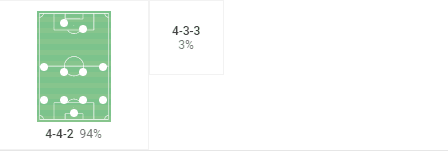
Villarreal is a team that likes to control the game with possession but doesn’t rely on controlling the game through possession. Emery has set the team up to be effective both with and without the ball. The 4-4-2 is ideal for this which is why it has become the go-to formation that Emery deploys at the Ciutat de València.
Defensively, the two banks of four players provide good defensive stability. The shape naturally creates a funnel to force the play into wide areas and away from the goal which gives you central compactness and the team can fluidly change its defensive shape to 4-1-4-1 without causing any disruption.
In attack, they use numerous players in a narrow shape as two strikers allow you to vary your approach, offering benefits that support direct play and possession play. Having a fullback and a winger on both channels allows the team the chance to double up out wide which then means you can stretch the opposition laterally.
Attacking approach
This season Villarreal has averaged 55.9% possession in the seven games played in La Liga. This is the fifth highest in the league so far and shows that Emery has a preference for Villarreal to keep the ball and dictate the game by keeping possession.
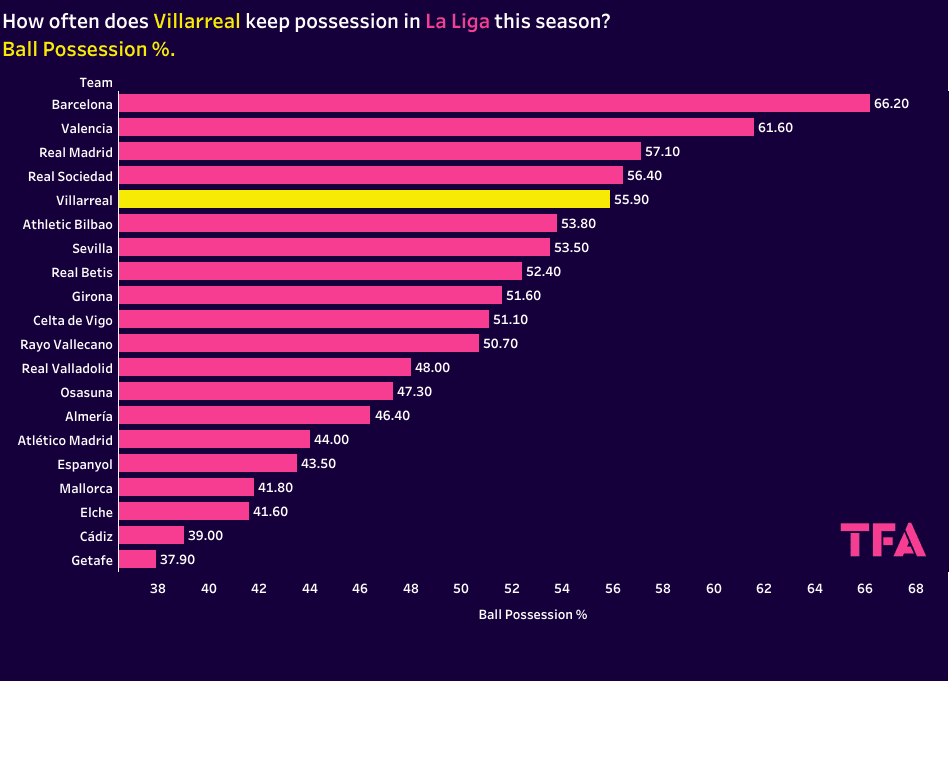
Build up Stage
During the build-up phase, Villarreal looks to build up from the goalkeeper and through the defence. Their build-up play is very structured which the image below shows. The central defenders both split and drop into the penalty area and the goalkeeper plays an active role in the build-up even after he releases the first pass.
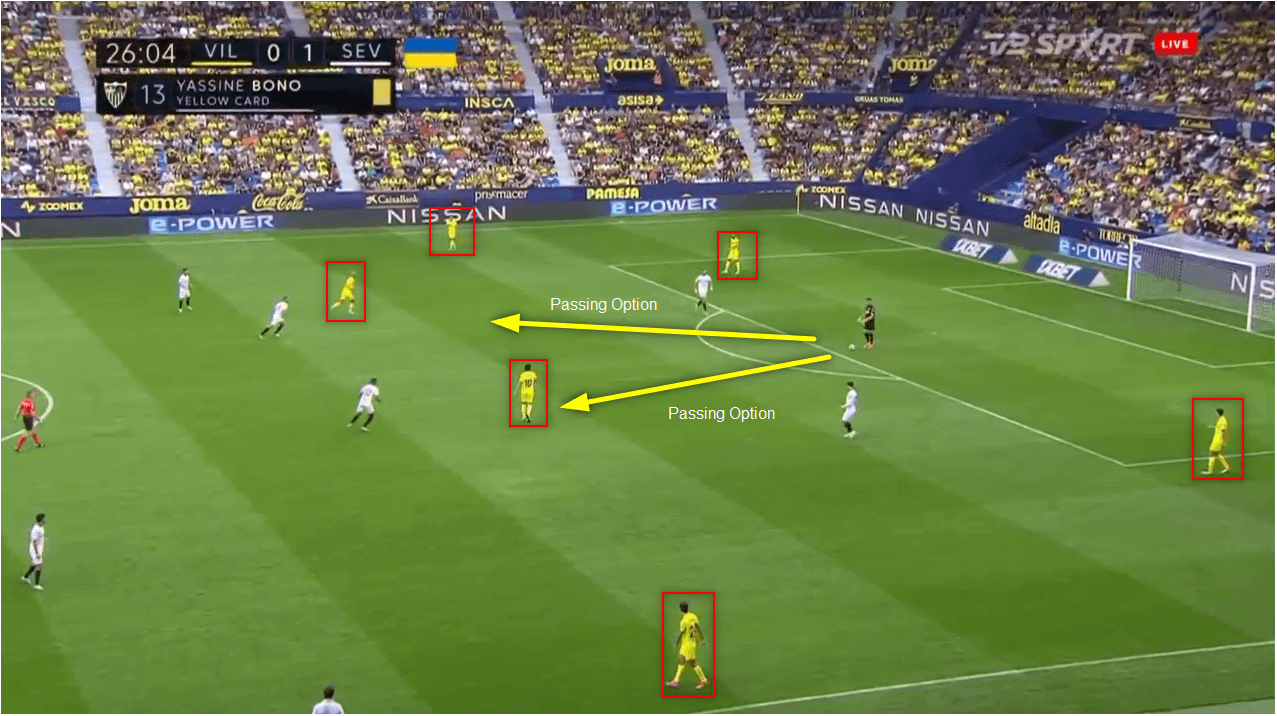
The reason the centre-backs drop into the penalty area is to provide a decoy as they don’t receive the ball. The position they take pulls the opposition’s forward players closer to Villarreal.
This creates space for Villarreal’s double pivot in midfield to receive the ball, and Villarreal build ups always starts in this way, the goalkeeper playing into the midfield and then the midfield will play it back to the centre backs or the goalkeeper who remains in his position and acts like a third centre back. The goalkeeper being involved in this manner means he will invite pressure when carrying the ball, making it easier to beat the opposition’s press.
The idea behind this play is to create a better opportunity to progress the ball vertically. It’s high risk but the reward is there as it attracts the opposition towards the ball which creates bigger spaces between their defensive lines and brings them further away from their own goal.
The image below shows the full structure of Villarreal’s tactics from their build-up and how well they draw the opposition in to create an easier route to progress through to the next stage of play. When the two centre midfielders drop towards the edge of the penalty area to receive the ball from the goalkeeper, the wide players move inside. The 4-4-2 formation then becomes a 4-2-2-2, creating a box shape midfield and a central overload.
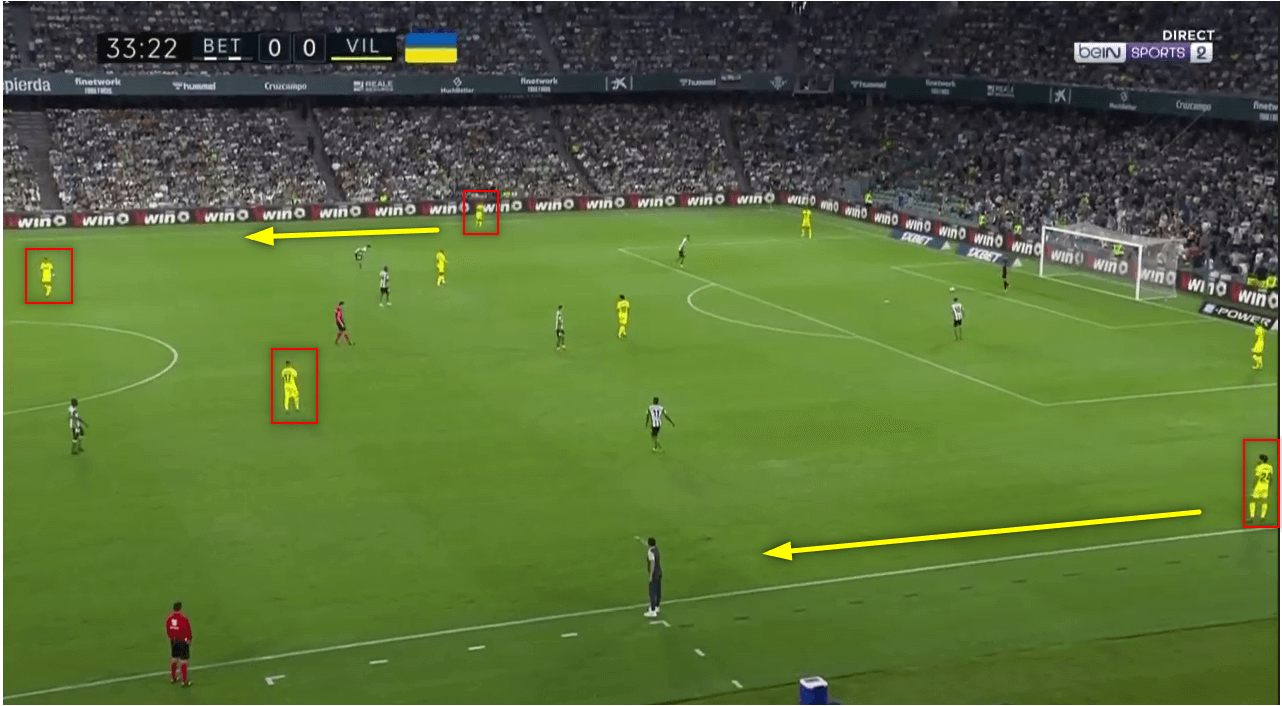
This inevitably creates more central passing options. You can see how Real Betis’ midfield four have pushed high up to try and win the ball during the build-up. Betis have six players in Villarreal’s defensive third of the pitch.
Villarreal’s wide players moving inside makes Betis more compact which then creates space out wide for the fullbacks to exploit and because Villarreal’s two centre midfielders drop into the defensive third, the wide players gather more space between the lines once they have come inside.
Creative Stage
Once Villarreal progresses further forward in attack, they become a lot more purposeful with their possession. During the build-up phase, they are a lot more patient, and Unai Emery is happy for them to pass the ball around the defensive third until the right opportunity to progress forward becomes available.
When they are higher up the pitch in the middle third, they look to get the ball into the attacking third as quickly as possible. In this image, Sevilla has successfully negated the Villarreal box shape midfield and central passing options by congesting the centre of the pitch. However, because the two wide players Coquelin and Le Celso are sitting inside and the two centre forwards have pulled onto the outside of Sevilla’s centre backs and looked to run in behind. This provides Villarreal with the chance to go direct behind Sevilla’s defence, but the run also stretches Sevilla’s defence and pushes them back, creating a bigger space between them and the midfield.
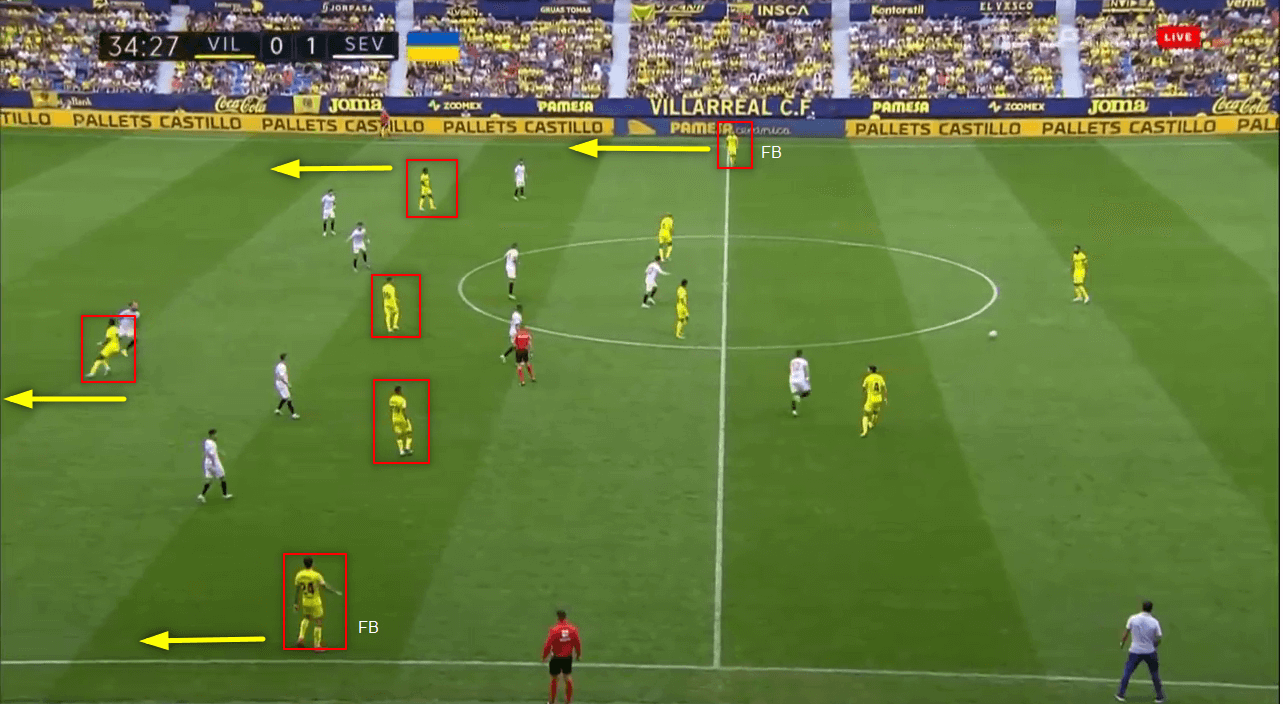
The position of the fullbacks is worth noting. We mentioned how Sevilla negated Villarreal’s option to play vertically through the centre by congesting that area and being compact, the full-backs pushing wide and keeping the width allows Villarreal to have an attacking outlet at all times.
Scoring Stage
In the attacking third, the fullbacks provide the width. The wide players remain inside and attempt to overload the penalty area, like below.
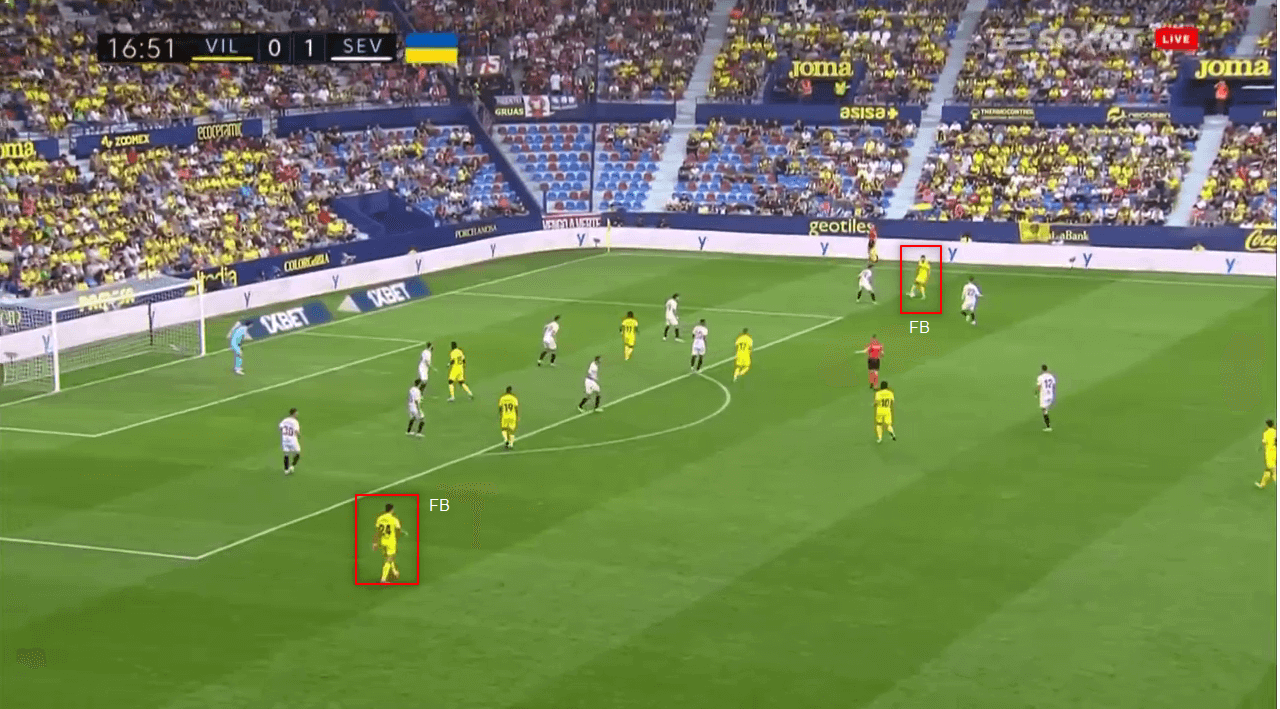
When Villarreal plays a team who implements a low block and gets men behind the ball, attacking through the wide area and the full-backs is a common trait.
If their opponent presses them high and Villarreal manages to beat that press, they attack through the centre and use the full-backs position out wide as a decoy. The example below is the type of situation Villarreal is looking to create when the play out from the defence, disrupting the opposition’s defensive shape and creating space to attack.
You can see how the box shape midfield has now progressed to a box shape attack. The wide players have come inside and are exploiting the space between the lines and the ball carrier has three players ahead of him all running into different areas of space to receive the ball, making it difficult to stop.

The data we have compiled below shows how well Villarreal has performed with their attacking output so far this season.
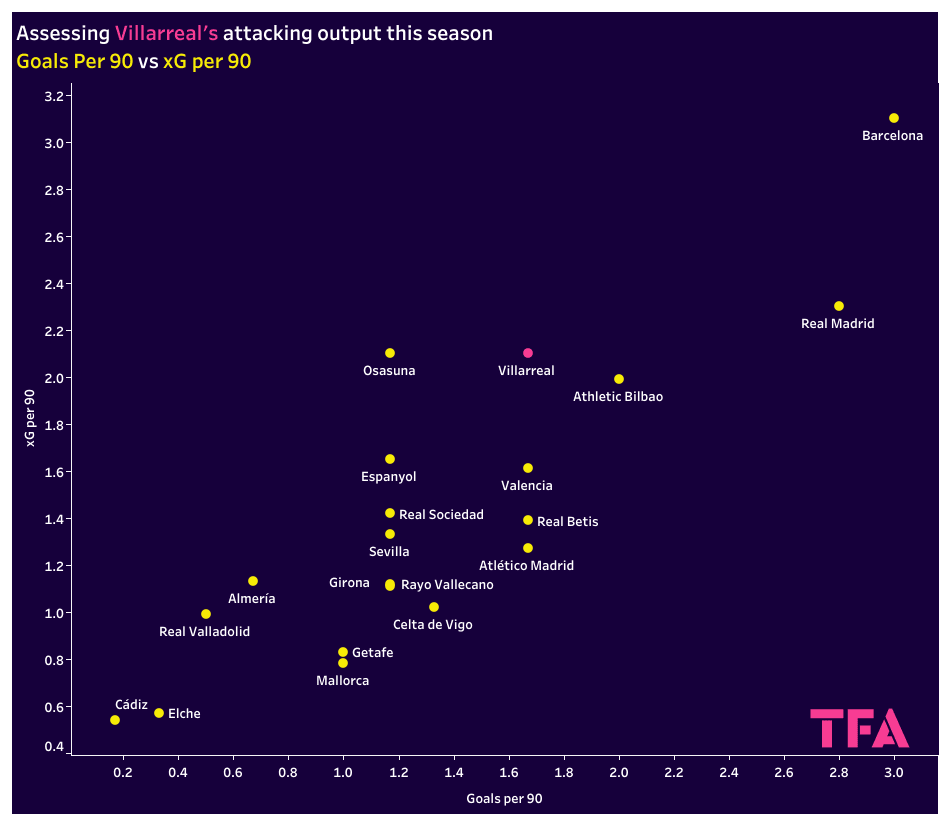
It’s still early in the season but they currently have the fourth best-expected goals per 90 and joint fourth best with Valencia, Atletico Madrid, and Real Betis for the number of goals per 90. This shows they are not scoring as much as they are based on the quality of chances they have had at this point. However, as the teams have only played a low number of games, the difference is standard and not yet at an alarming rate.
Defensive Phase
This season and throughout most of Unai Emery’s time in charge Villarreal have typically adopted a 4-4-2 defensive shape that makes them difficult to break down. They minimise the space between the lines which forces the opposition out wide where Villarreal will then commit to pressing more aggressively.
Emery prefers Villarreal to keep a solid defensive shape when the team are out of possession, and he is happy for his team not to win the ball back immediately. Preferring his team to control the space and timing their decision to attempt to win the ball. Villarreal still presses its set by triggers and is man orientated whilst the rest of the team keeps their shape.
We have measured Villarreal’s challenge intensity against the number of passes per defensive action they allow their opponents when they hold possession. Their challenge intensity is 5.4 duels, tackles, and interceptions per minute of opponent possession and their PPDA is 10.66.
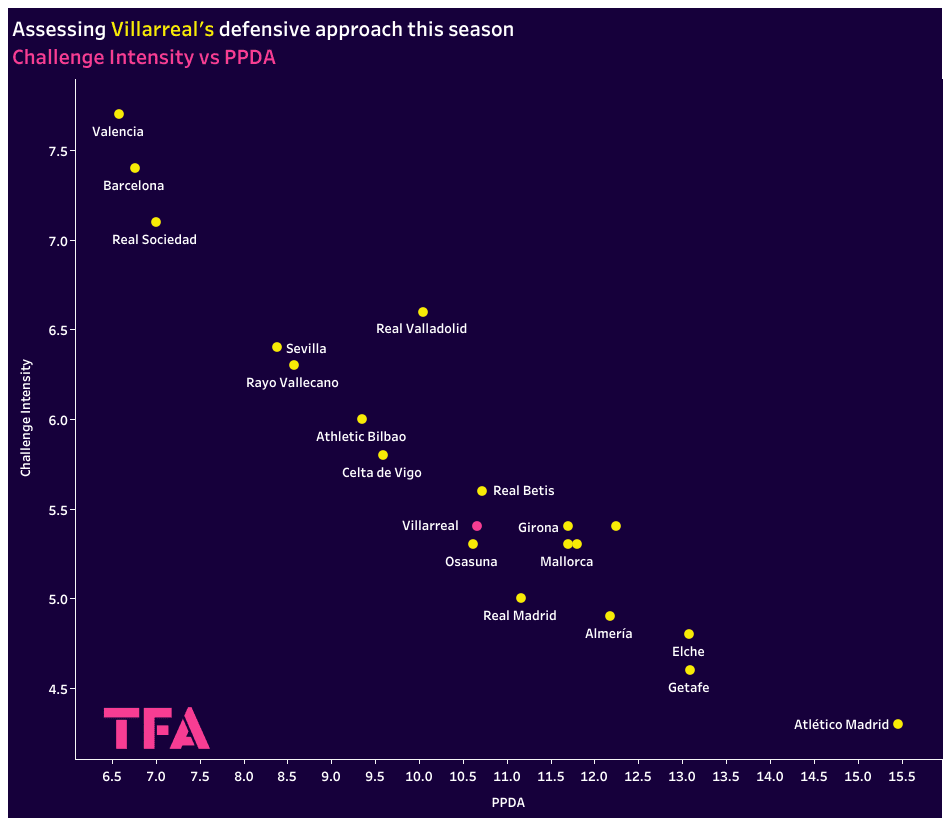
High Block
They switch their defensive block depending on the area the opposition holds the ball, but the structure remains the same. If their opponents hold possession in their defensive third then Villarreal will perform a higher defensive block, like below, looking to win the ball and stopping the opposition from playing through them.
You can see how they look to hold their shape and don’t press against the ball at this point in the play. This is because no pressing trigger has been hit at this point. Any player that starts to press leaves a space to play through. Once this happens it becomes difficult for the team to stop the opposition from progressing further up the pitch.
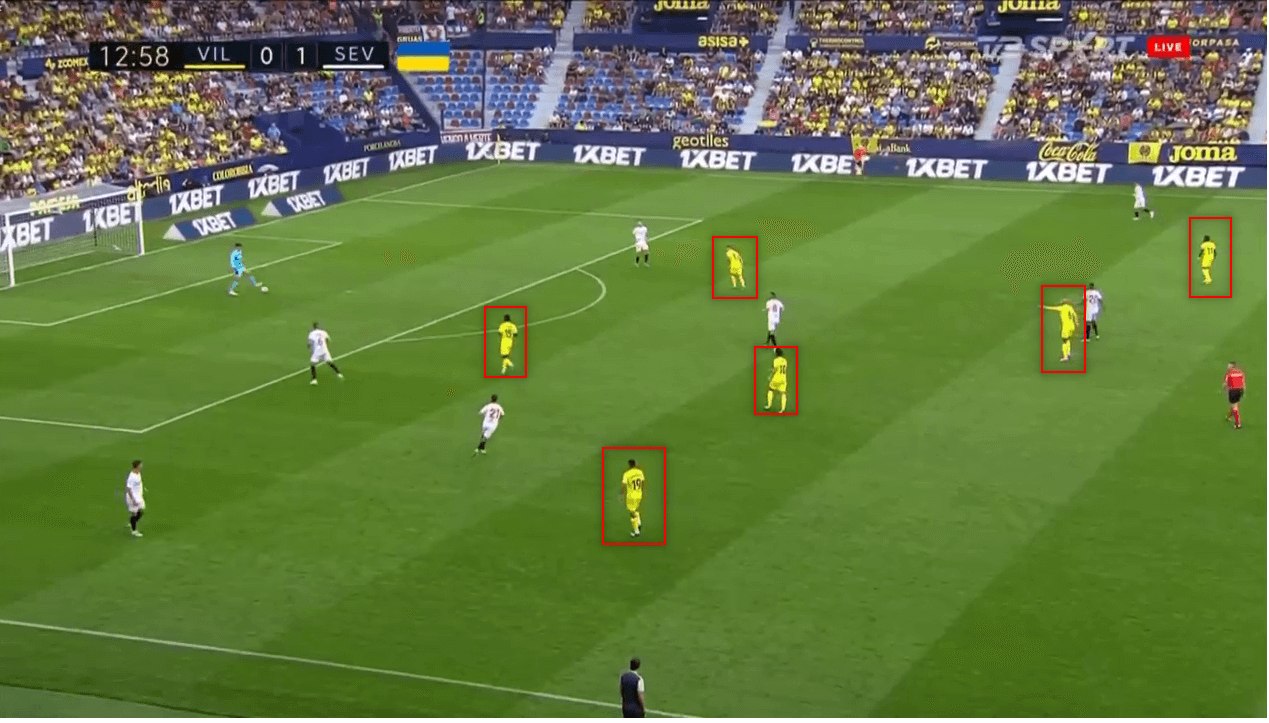
The trigger to press comes when the goalkeeper plays the ball out wide or if the goalkeeper plays it into the centre back and the centre back plays it back to the goalkeeper. It’s the pass backwards allowing Villareal to start pressing the ball.
Then Villarreal will look to condense the space down whichever channel they are attempting to play through and force their opponents into conceding the position.
The images below show how Villarreal has cut all the viable passing lanes off, forcing the defence into conceding the ball as he clears the ball long.
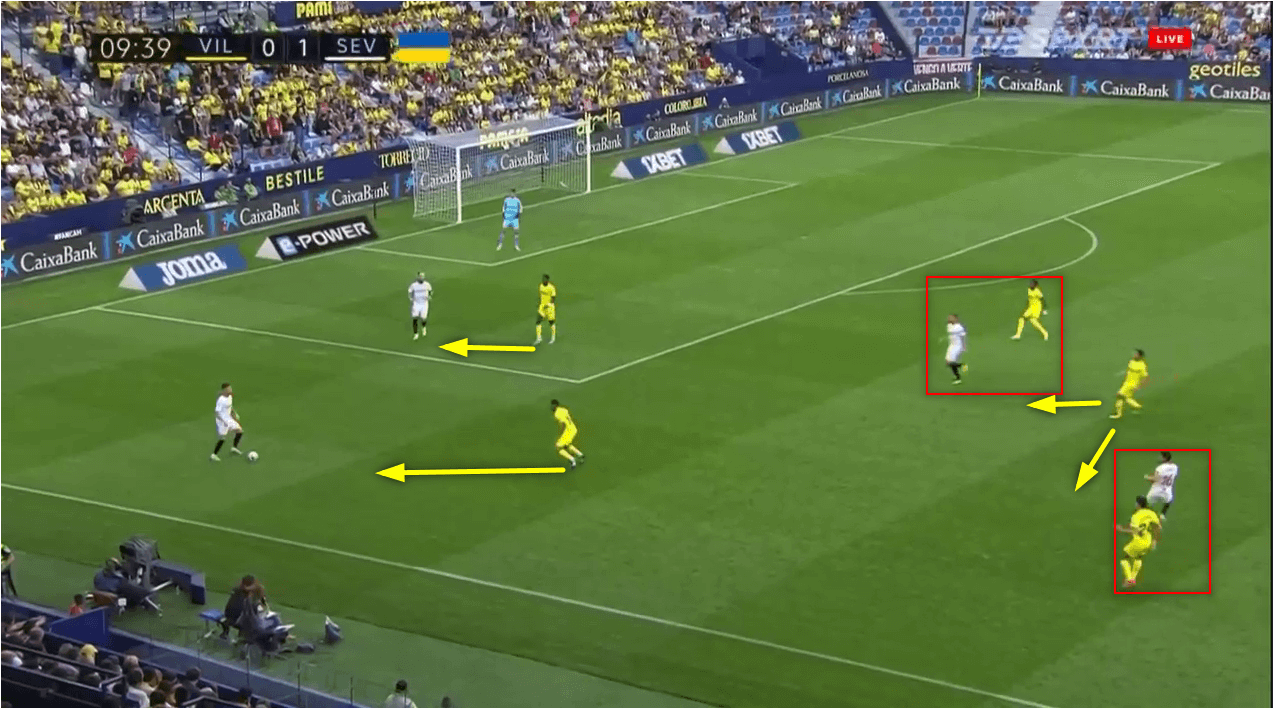
Mid-Block
When Villarreal is sitting in a mid-defensive block, they are more efficient. They keep minimal space between the lines and force the play away from the central part of the pitch, with each player pressing as the play comes into their zone, in a man-oriented pressing structure. Also, it provides them more of an opportunity to counter if they intercept and win the ball. due to the opposition being higher up the pitch.
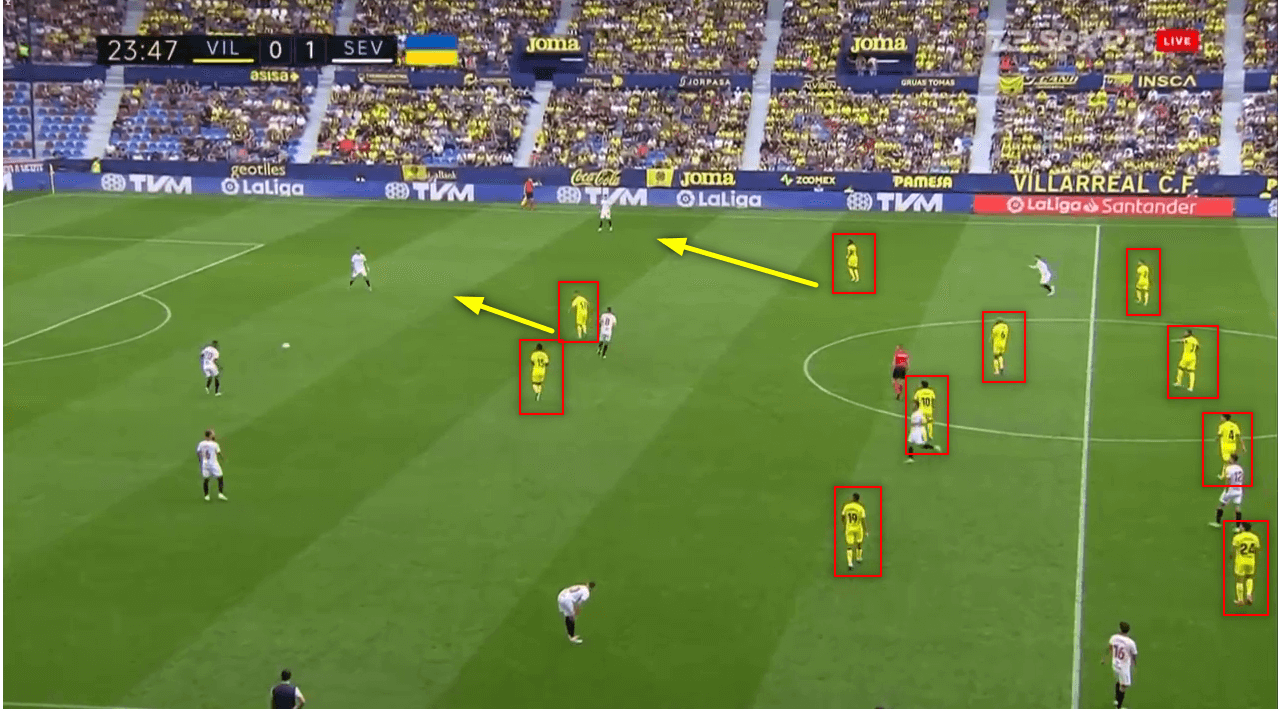
The defensive shape and trigger for the press are led by either of two strikers, whichever is the closest of the two to the play to restrict the ball to one side. The moment Sevilla plays the ball to the left-sided centre-back, it triggers Le Celso to start putting pressure on the ball. This is when Villarreal starts to funnel the play onto one side and shift across as a team and blocking any passing lanes for the ball carrier, as shown in the image below
Villarreal quickly shut down the play on Sevilla’s right-hand side. As Navas receives the ball, the left winger immediately closes down as do the other players that surround him. You can see how Sevilla is forced to play backwards as there are no safe passing options available. This triggers the team to start pressing and move up into a high defensive block.
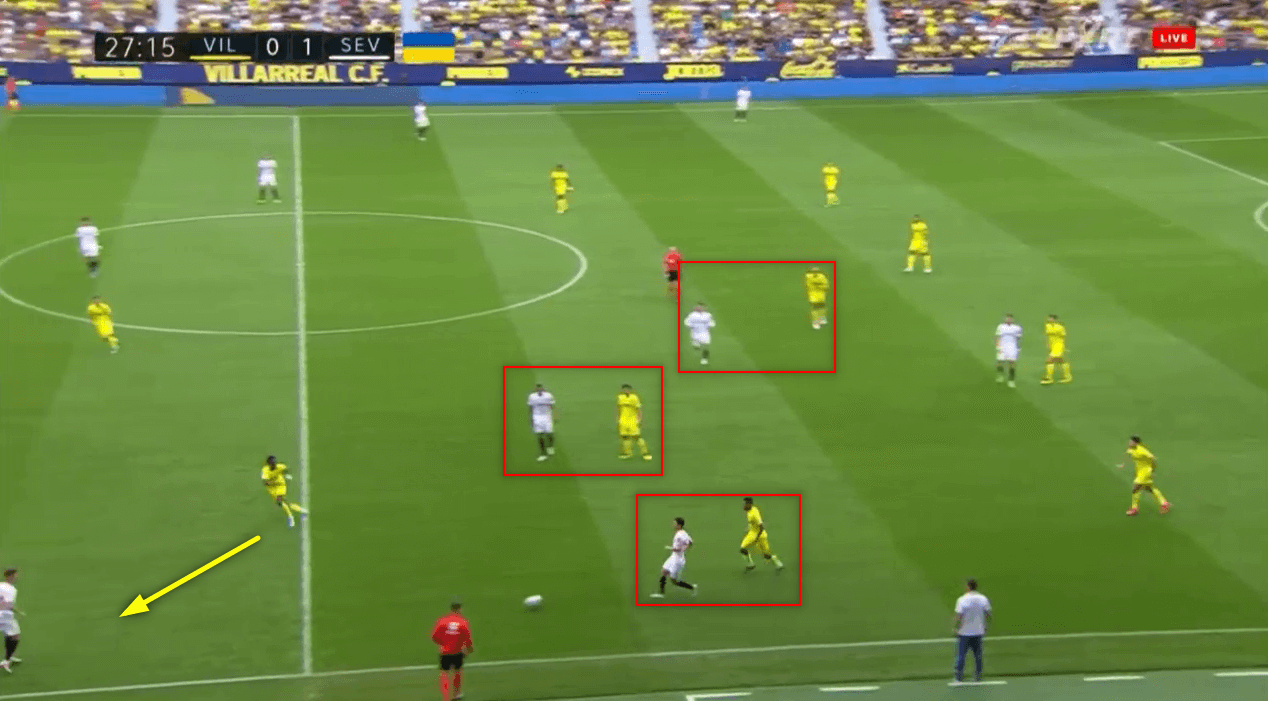
Low Block
The same principles apply when they are defending in their defensive third. Staying narrow and compact and forcing the opposition to cross from out wide is the tactic.
The space between the midfield and the defence becomes notably smaller when Villareal defends their penalty area as they look to give the centre-backs as much protection as possible. It also provides the team with a better opportunity to win the second ball if the opposition is successful at crossing into the penalty area.
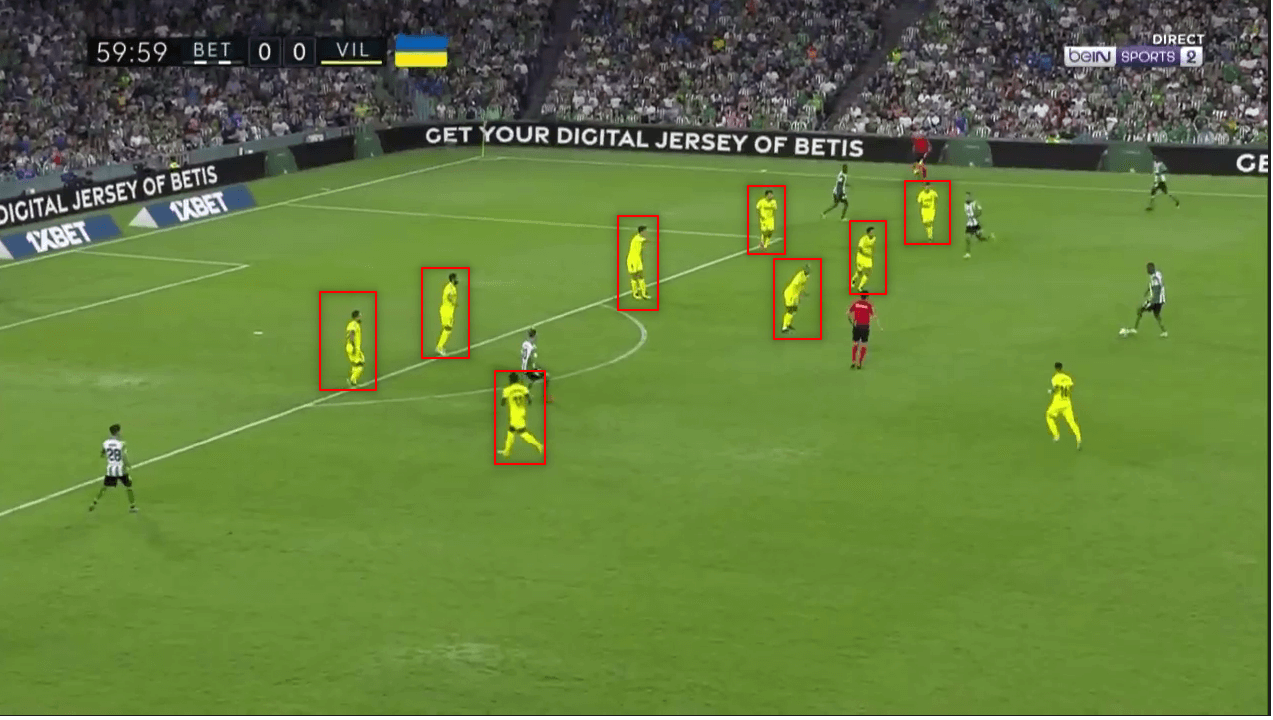
The image above shows how Villarreal’s two banks of four sit narrow and compact giving minimum space up between the lines and forcing the opposition to go around them.
The reason for this is that it attracts the fullbacks to push forward. When Villarreal employs their press out wide it gives them a good opportunity to counterattack.
Conclusion
This is a tactical analysis in the form of a scout report that focuses on Villarreal tactics this season, we have provided analysis on the different types of defensive blocks Unai Emery has implemented this season, along with their attacking structure.






Comments